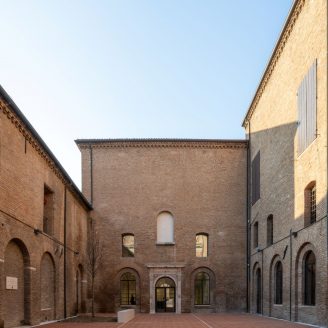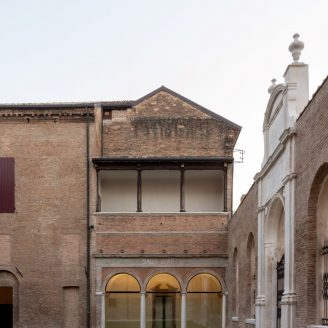The famous Palazzo dei Diamanti in Ferrara (Italy), a Renaissance masterpiece, has been recently reopened to the public after the careful restoration and refurbishment carried out by the architectural firm Labics, completed in February 2023.
The first intervention involved the main pre-existing exhibition spaces: the Rossetti Wing and the Tisi Wing. The rooms were equipped with high-tech surfaces, behind which all mechanical equipment is hidden. In the Rossetti Wing, new Venetian terrazzo floors were installed. New burnished brass portals were inserted in both wings to accentuate the spatial sequence of the Renaissance palace.
The second intervention involved the spaces formerly occupied by the Museum of the Risorgimento, which were completely renovated and designated for new functions to support the exhibition activities: coffee-shop, bookstore, educational room and multipurpose space. In addition, Labics renovated the courtyards within this section of the complex and reimagined them as “open-air rooms”, integrating them into the museum’s itinerary and thus highlighting the distinctive features of a building that alternates solids and voids, indoor spaces and enclosed outdoor areas.
The third intervention focused on ensuring continuity in both indoor and outdoor paths. Regarding the internal pathways, Labics reopened a significant connection that had been interrupted over time between the former Museum of the Risorgimento and the main courtyard. Additionally, they improved access through the small loggia that faces the main courtyard, making it an essential part of the visitor’s route.
The most significant intervention is the creation in the garden of a connection between the two wings of the Palace through a wooden structure, essential and light, partially glazed, which extends into the garden, highlighting its main geometries. The garden, conceived by Labics with landscape designer Stefano Olivari, recovers the layout of the ancient “brolo” (orchard) with its squares and rectangles and brings to light, in a contemporary key, the arrangement documented since the second half of the 18th century.
The interventions carried out for the Palazzo dei Diamanti constitute a cohesive set of actions aimed at both preserving the historic building, its spatiality, its intrinsic quality, and adapting its spaces to the needs of a modern exhibition venue. In conclusion, the project structures the paths of the monumental complex and establishes a contemporary idea of the museum space in the Palazzo dei Diamanti.






















